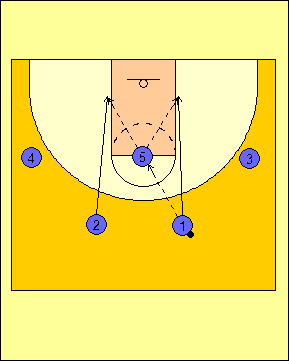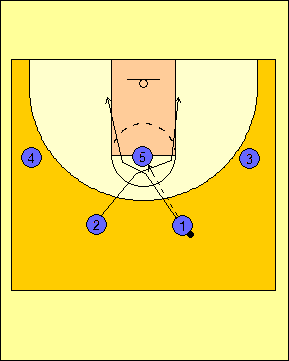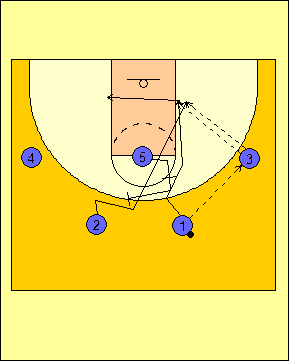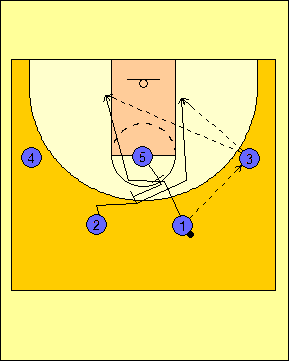|
HIGH POST OFFENSE
Teams such as UCLA, Princeton, Georgetown, Louisville,
and others have had great success attacking defenses with the high post
offense. This offense is noted for its versatility and its ability
to take advantage of five players who can share the basketball and pass
it effectively.
Advantages of the High Post Offense
Because the offense is run off of the baseline, it draws the defense from the
baseline. This opens up the area below the free throw line-extended for
backdoors and post-ups. Because of the 2-3 set-up of the high post offense
with the forwards at the wings and the center in the high post, the defense can
be put into situations where they have to make decisions as to how they intend
to guard the offense.
If the defense decides to guard the offense between the man and the basket, the
perimeter jump shot becomes a real possibility. Meanwhile, if the defense
tries to pressure the offense, backdoor lay-ups open up for the offense.
Dead fronts of the high post can also lead to problems in that the lob pass
becomes a possibility to where the center can score easily at the basket.
Second, the offense is versatile when it comes to tempo. Depending on how
the offense plays the defense, it can be a quick-hitting offense or it can run
copious amounts of time off of the clock. If the shots come quickly in the
offense, we would prefer that it be the result of a defensive breakdown like
that of what would be found running any other offense.
Finally, the offense also lends itself to other offenses and offensive
alignments. When the offense breaks down, there are a number of offenses
that the high post offense naturally flows into including motion, the Flex, and
even the pick-and-roll offense. Also, the offense lends itself to
five-out, 2-3 high, and 2-2-1 alignments that can be used to attack the defense.
Disadvantages of the High Post Offense
One of the problems with the offense is that it requires a center who is an
outstanding passer who can play away from the basket. The center must be
able to play at least 15 feet from the basket and will be used as a passer a
great deal of the time. If you cannot trust your center to handle the
basketball and be a threat to score away from the basket, running this offense
will not benefit your team.
The other problem is that since the offense has four perimeter players in it, it
requires that all four perimeter players must be capable of shooting from the
perimeter. Because the offense is perimeter oriented in nature, the
players on the perimeter must be capable of scoring from the perimeter.
Guard-to-Post Pass
The first option in the high post offense is to get the
ball to the high post. When this is done, the passer will initiate
the action that will follow. The passing guard can dive to the low
block on his side which will prompt the opposite guard to dive to the
opposite low block (Diagram 1). The look for the center is to hit
either one for a backdoor lay-up.
The other possibility is to run a post split with a
handoff to either guard (Diagram 2). If the guard gets the ball,
we want him to score. If not, we will run from a three-around-two
alignment which will be described in greater detail later on in the
article.

Diagram
1 |

Diagram
2 |
Guard-to-Forward Pass
When the guard makes a pass to the forward, the offense can go one of two ways:
First, the passing guard can make a UCLA cut to the direction of the pass with
the other guard receiving a back screen from the center on a Hawk cut (Diagram
3).
Second, the passing guard can make a UCLA cut away from the pass and
the other guard uses the back screen from the center to make a Hawk cut
(Diagram 4).

Diagram
3 |

Diagram
4 |
Guard-to-Guard Pressure Release
If at any moment we cannot make a pass to the
ball-side forward or the center, a pressure release can be made by
making a simple pass to the opposite guard (Diagram 5). From
here, the guard who receives the pass can pass to either the forward
on his side or the center in the high post area.

Diagram
5 |
Dribble Entry
If we cannot make a pass to the guard, forwards, or
center, we can use a dribble entry to get the offense into action.
If the defense overplays the passing lane, the forward will fake
high and cut backdoor (Diagram 6).
Should the defense sag off, we will run a dribble handoff (Diagram
7).
When this happens, the help-side guard dives to the help-side
low block and the help-side forward v-cuts and replaces the
help-side guard.

Diagram
6 |

Diagram
7 |
Running the Offense
Whenever the ball is passed from the guard to the
forward and the guards have made their cuts. We get into a
three-around-two alignment as shown in Diagram 8. Whenever
this happens, we want to get the ball to the center in or near the
free throw circle.

Diagram
8 |
When the center gets the ball (whether it is from
the feed to the center by a guard or by a forward), we have two
options as to how we want to get our guards back on top with the
basketball in their hands. The first is to have the guards
cross before coming off of the down screens set by the forwards
(Diagram 9). The other is for the guards to come off of the
down screens on their respective sides (Diagram 10).

Diagram
9 |

Diagram 10 |
When the ball is passed to a guard off of either the
down screen or the guards crossing underneath, the center will cut
directly to the basket. The forwards can either pop out to the
wings (Diagram 11) or cross and come out on opposite sides (Diagram
12).

Diagram
11 |

Diagram 12 |
If we make a guard-to-forward pass, we will look to
get the ball inside to the center (Diagram 13). After the
guard-to-forward pass is made, the guard who makes the pass
If we are unable to make the pass to either the
guard or the center on the post-up, the center will screen away to
bring the help-side guard to the low post on a Hawk cut (Diagram
14). When this happens, we will get back into a
three-around-two alignment.
Should the guard be unable to pass to the forward,
the center will come high and the 2-3 high set comes back into play.
This could be triggered by a denial to the forward or a
guard-to-guard pass.

Diagram
13 |

Diagram
14 |
Counter from 3 Around 2
After the ball is passed to a forward and the
offense gets into a three-around-two alignment, we want to get the
ball to the center. If we are unable to do so, we have a
counter as shown in Diagram 15. The center will start toward
the ball to get the defender up the floor before cutting backdoor.
Meanwhile, the guards clear off of the blocks to open up room for
the cutting center.
If the center cannot get the ball on the rim run, he
will step to the ball and the guards will come high and change sides
of the floor as shown in Diagram 16. We want the guard who
starts on the same side as the ball in this scenario to rub the
center's man off of him so that we can get a low post entry.

Diagram
15 |

Diagram 16 |
Teaching the High Post Offense
For an offense like this, it is best to teach it with
five players running the offense with no defense. The options can
be presented to the players and can be practiced. It is important
that the players realize what they can do in the offense and how they
can score within the structure of the system.
The offense can also be effectively taught by breaking
down certain aspects with two offense players or three offensive
players. To make this work best, start with no defenders involved
in the maneuver you wish to teach before adding the defense to it.
Once you are done with this, bring back the offense to its
five-on-zero/five-on-five work.
RETURN TO MEMBERSHIP AREA
© 2010-2017 Alan Peel Enterprises
|